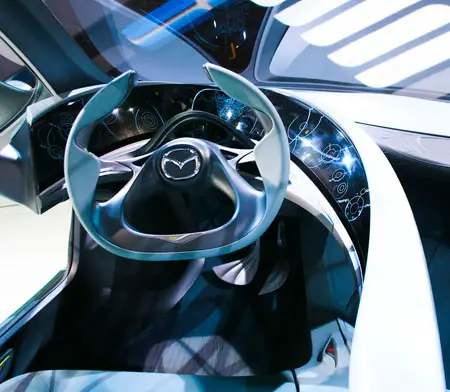Ford's interior design team, led by Nikolaus Vidakovic, have created a dramatic and exciting interior for iosis X.
�We started with all of the positive elements from the original iosis project, and evolved these to deliver even more visual interest and drama that you might not expect from a crossover,� Vidakovic explained.
The interior is dominated by a new 'interlocking bridge' centre console structure inspired by modern helicopter cockpit design. The large console dives down from the instrument panel dividing the front and rear pairs of seats and dominating the interior before dramatically sweeping upwards at the rear and into the roof.
"Think of a Scorpion's tail!" added Vidakovic.
The rear section of this console has a practical side to it as well, as it provides a support and opening mechanism for the one-piece rear hatch in place of traditional hinges. It also provides a secure location for the spare wheel.
A central overhead panel contains personal lighting for the front and rear occupants plus ambient lighting and an entertainment screen for rear passengers. It also houses three passenger grab handles which would traditionally be located on the cant rails above the doors.
Twin glass roof panels flank the central overhead console, and these are complemented by a totally unique new feature � a solid glass floor beneath the drivers and passenger seats which offers a most unusual view of the terrain below.
�Because this is a rugged crossover rather than a four-door coup�, we needed to make different interior design decisions," Vidakovic said. "At the front, you have the usual functional elements you need to control a car, but when you go rearwards we introduce elements more appropriate to this type of vehicle such as lighting and storage features.�
The slim instrument panel is a further development from that in iosisand some elements of this theme will undoubtedly feature in future Ford products.
New technology has allowed the interiors team to locate hardware for the information, entertainment and heating, ventilation and air-conditioning systems remotely away from their controls. This has dramatically freed up space under the instrument panel, creating a floating centre console and offering a greater feeling of spaciousness. It also allowed the team to develop a range of practical storage facilities that customers could choose from, allowing them to tailor that area for their own needs.
A similar section in the rear console opens up the floor space for the back seat passengers.
The slim instrument panel flows through into the door lines, creating a dramatic cockpit feel for the front seat occupants. Facing the driver is a radical steering wheel developed from that used in the original iosis, featuring orange perspex sections and contrasting white 'piano' inserts.
The controls in iosis X employ soft touch screens and touch sensitive controls in the centre stack.
The main instruments present themselves in the form of a pair of orange illuminated transparent foil dials that create a deep 3-D effect, and are housed in individual goggle-like binnacles. Between them is a Ford HMI screen that allows easy driver control of navigation, advanced cruise control or other vehicle settings.
Although iosis X is not intended to be a mechanical prototype, it is fitted with an electronic sequential gear change control in the centre console. Its innovative design is similar to that found on many computer games consoles, and fits snugly into the palm of the hand. Surrounding the gear shifter is a series of soft touch buttons for dynamic controls, including suspension and traction settings.
Air vents, which are usually a dominating feature of any fascia, have been subtly disguised with fine mesh blending them into their surroundings.
�We�ve spent a lot of time developing this mesh over the years,� revealed Vidakovic. �It took a lot of work to get it right so that the mesh wouldn't vibrate or restrict air flow to the passengers.�
Orange mood lighting, created by light emitting diodes and light pipes, illuminates the interior. However, not much lighting is needed in a car that features not only frosted glass panels in the roof (to continue the twin silver stripes from the bonnet over the roof) but also a glass floor.
�We wanted to create the feeling that driver and passengers are connected to the outside world and can see their surroundings more clearly," Vidakovic said. "The glass floor is absolutely unique in a vehicle, like those that you get in boats which allow their passengers to look into the ocean. In this case, occupants will be able to see the elements beneath them as they travel.�
The glass floor also led the design team to develop a unique mounting system for the front seats with runners either side of the glass panels. The added benefit to this is that it gives the rear seat passengers more foot room beneath the front seats.
The seats themselves are highly complex and have been designed specifically with the rigours of cross country or light off-roading in mind, featuring more supportive padding in the upper back section and integrated seat belts.
�We�ve bought trapezoidal elements and themes into the interior to link with the exterior, whilst the interior sheet metal and piano white surfaces are also links with the bodywork to create a harmonious entity,� concluded Vidakovic.
Subscribe to:
Post Comments (Atom)




0 comments:
Post a Comment